Abstract
OBJECTIVE--To examine the relation between birth weight and beta cell function in the first degree relatives of non-insulin dependent diabetic subjects. DESIGN--Cross sectional study of 101 adults of known birth weight from 47 families which had at least one member with non-insulin dependent diabetes. SUBJECTS--101 white adults aged mean 43 (SD 7) years. SETTING--Oxfordshire, England. MAIN OUTCOME MEASURES--Glucose tolerance was measured by continuous infusion glucose tolerance test. beta cell function and insulin sensitivity were calculated from the fasting plasma glucose and insulin concentrations with homeostasis model assessment. beta cell function was standardised to allow for the confounding effects of age and obesity. RESULTS--Twenty seven subjects had non-insulin dependent diabetes, 32 had impaired glucose tolerance, and 42 were normoglycaemic. Birth weight correlated with the beta cell function of the complete cohort (rs = 0.29, p = 0.005), the non-insulin dependent diabetic subjects (rs = 0.50, p = 0.023), and the non-diabetic subjects (rs = 0.29, p = 0.013). The non-insulin dependent diabetic (n = 27) and the non-diabetic (n = 74) subjects had similar mean (inter-quartile range) centile birth weight 50% (19%-91%), and 53% (30%-75%) respectively. Non-insulin dependent diabetic subjects had significantly lower beta function than the non-diabetic subjects: 69% (48%-83%) v 97% (86%-120%), p < 0.001. CONCLUSIONS--The cause of the association between low birth weight and reduced beta cell function in adult life is uncertain. Impaired beta cell function in non-insulin dependent diabetic subjects was not accounted for by low birth weight, and genetic or environmental factors are likely to be necessary for development of diabetes.
Full text
PDF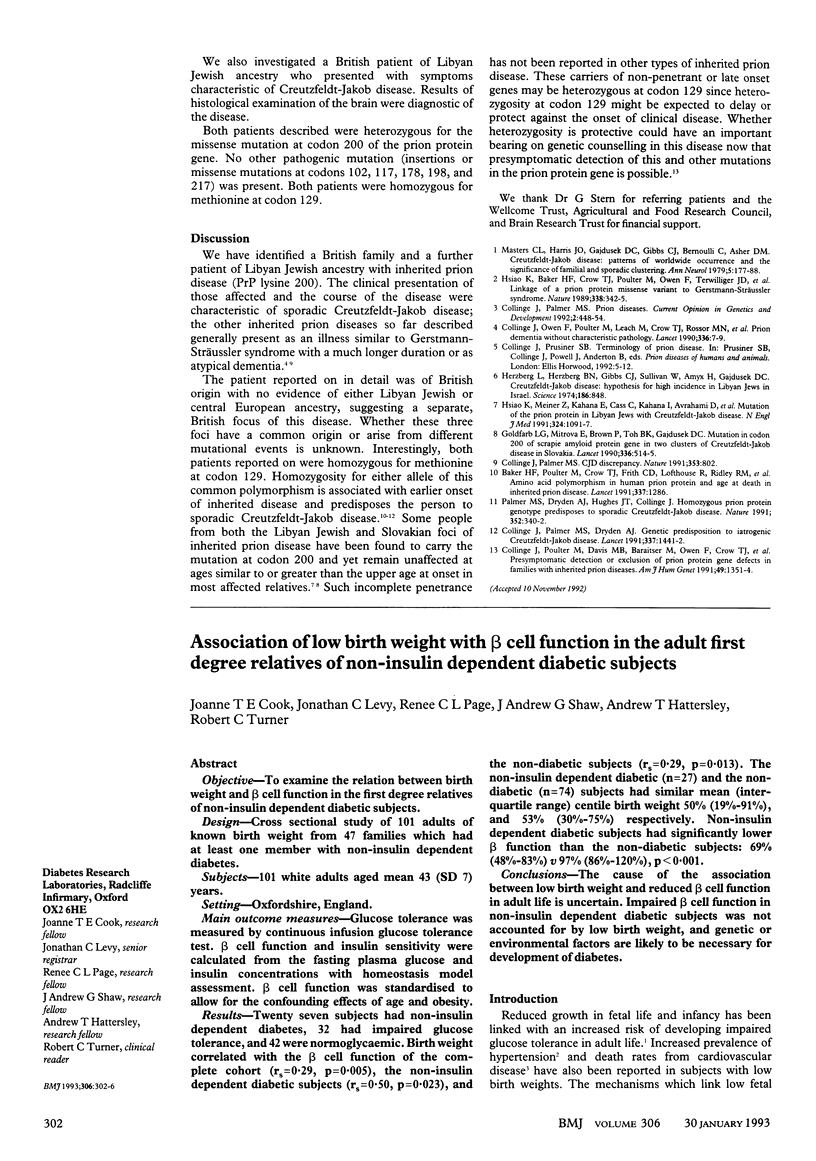
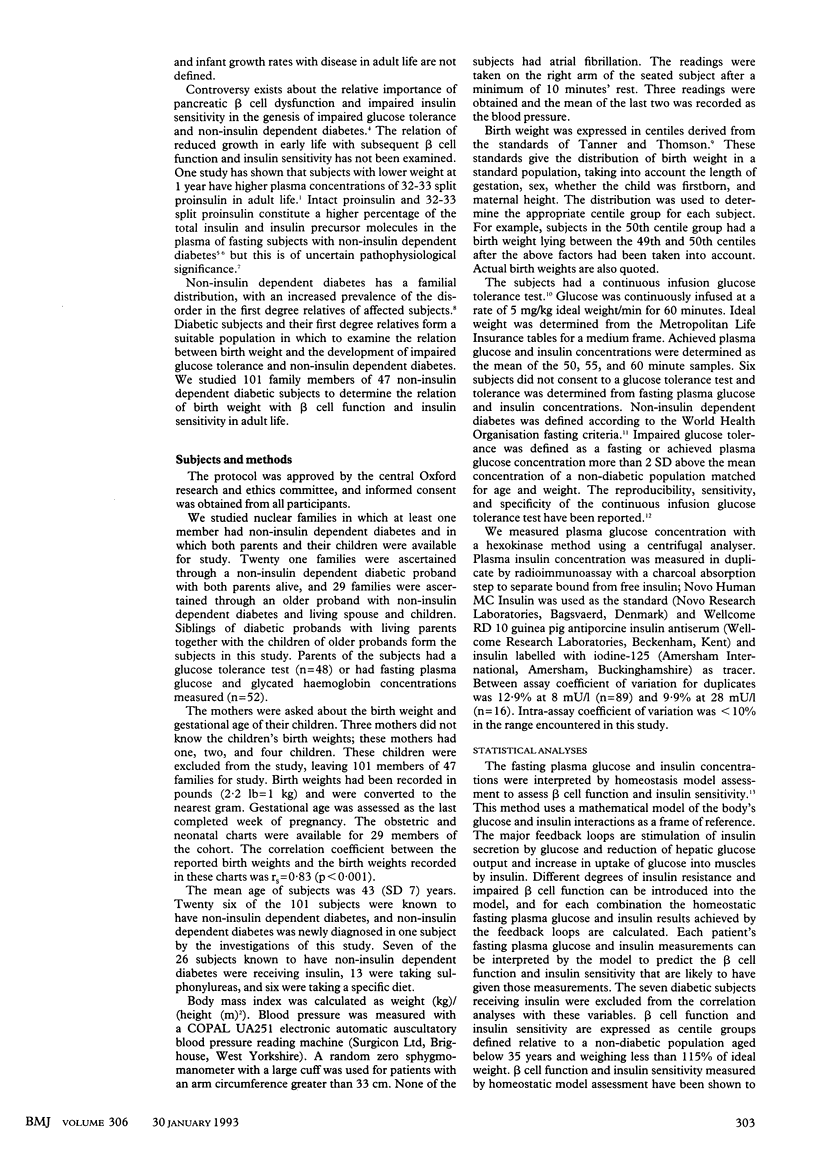
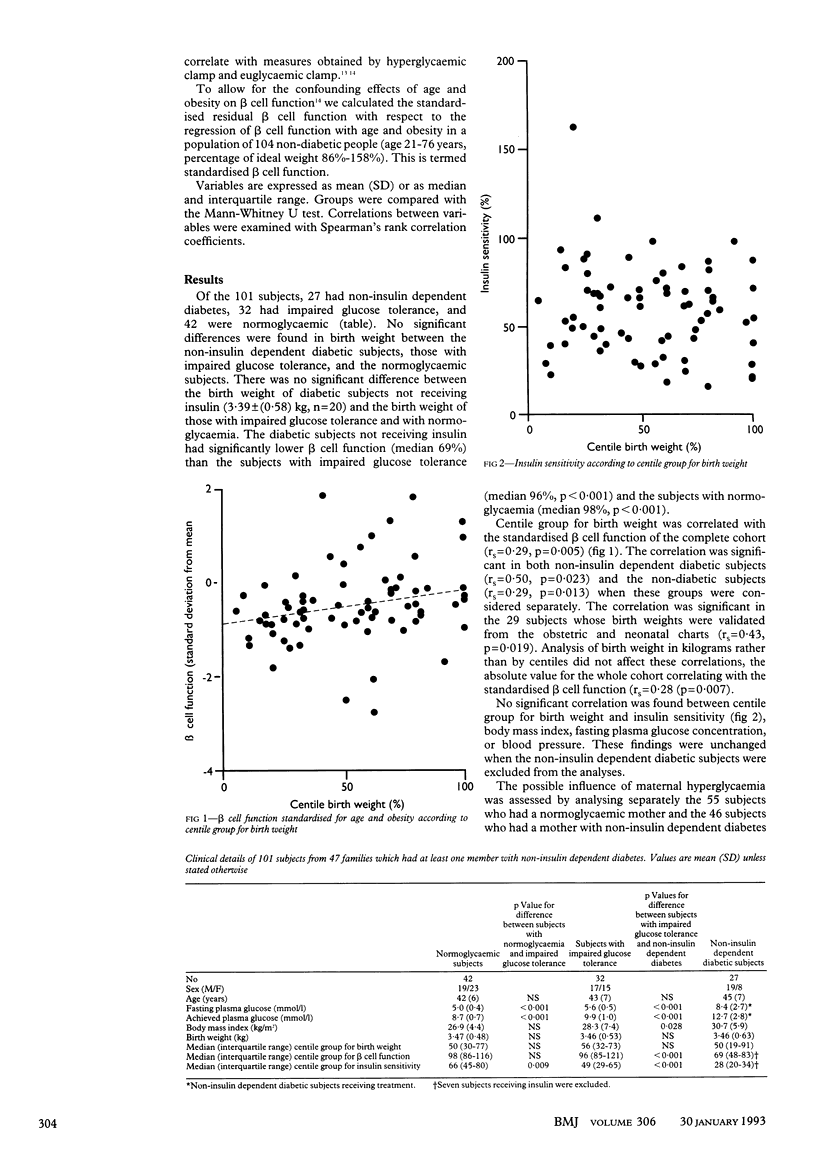
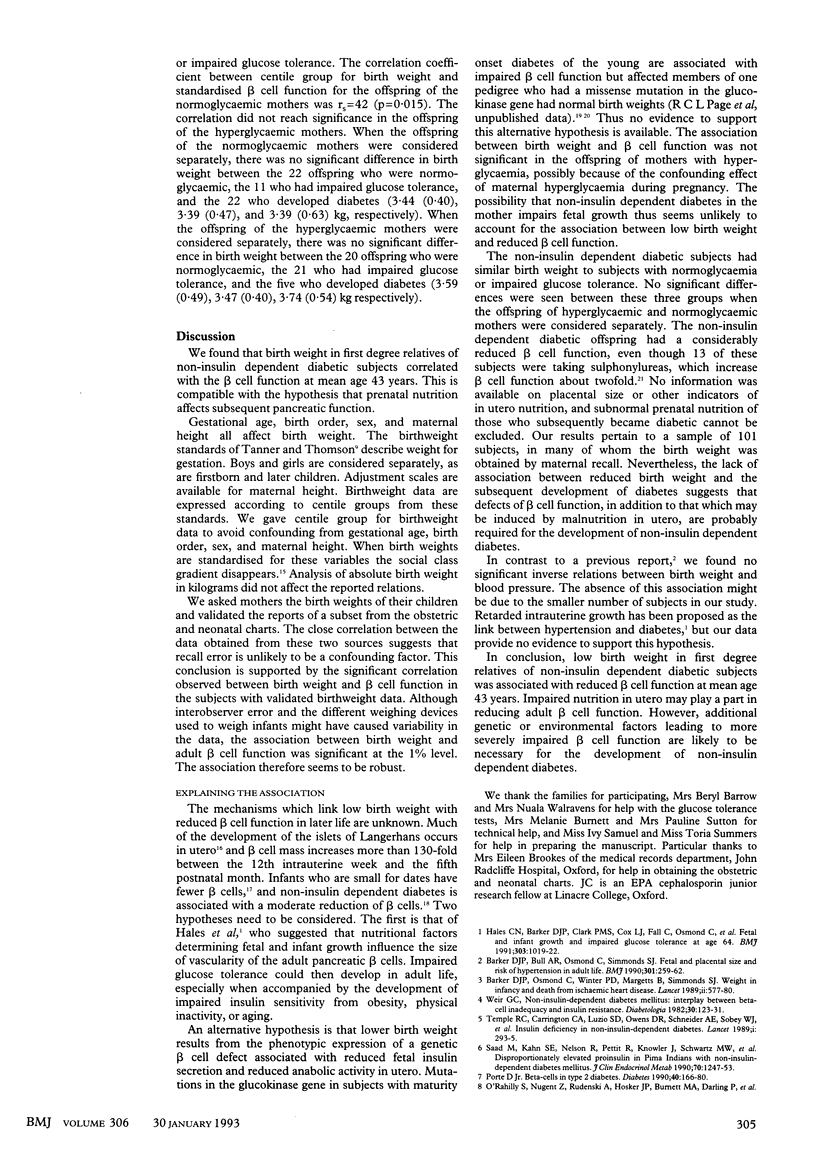
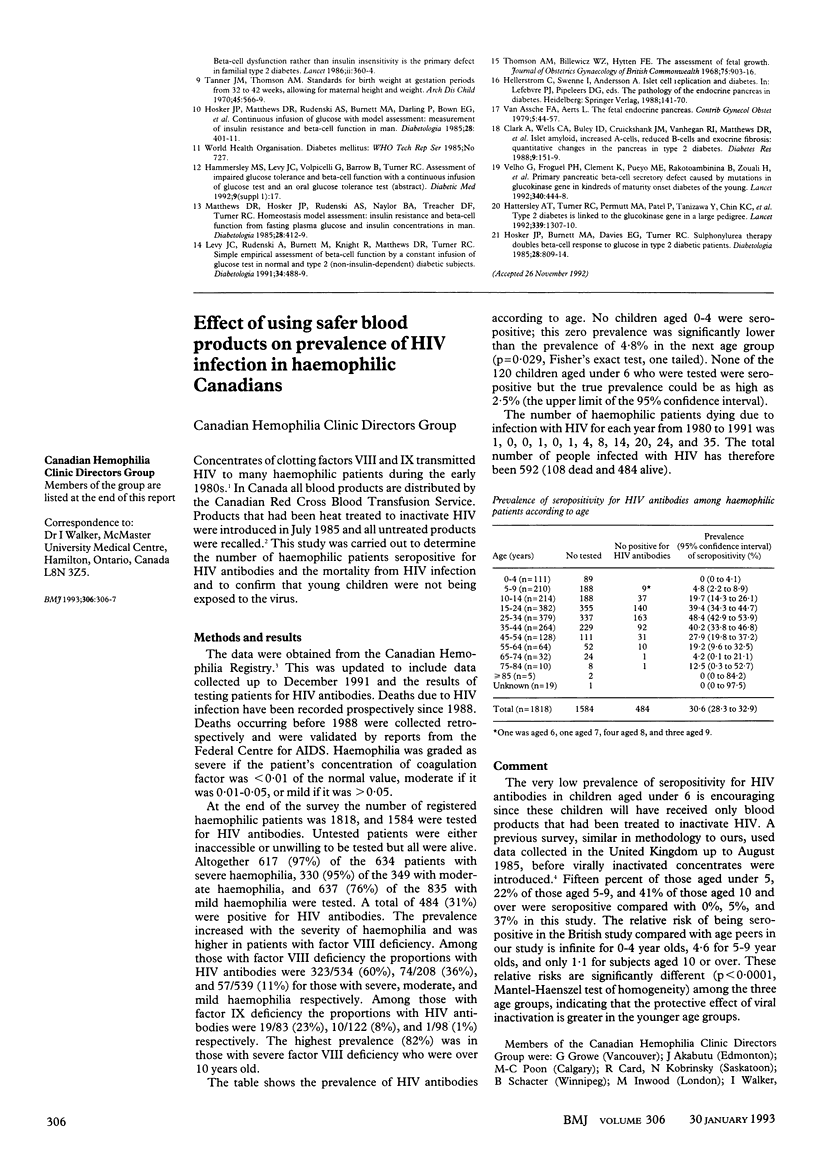
Selected References
These references are in PubMed. This may not be the complete list of references from this article.
- Barker D. J., Bull A. R., Osmond C., Simmonds S. J. Fetal and placental size and risk of hypertension in adult life. BMJ. 1990 Aug 4;301(6746):259–262. doi: 10.1136/bmj.301.6746.259. [DOI] [PMC free article] [PubMed] [Google Scholar]
- Barker D. J., Winter P. D., Osmond C., Margetts B., Simmonds S. J. Weight in infancy and death from ischaemic heart disease. Lancet. 1989 Sep 9;2(8663):577–580. doi: 10.1016/s0140-6736(89)90710-1. [DOI] [PubMed] [Google Scholar]
- Buschard K., Birch K., Madsbad S., Röpke C. Metabolic state does not influence lymphocyte subsets in type 1 diabetic patients. Diabetes Res. 1988 Sep;9(1):15–18. [PubMed] [Google Scholar]
- Hales C. N., Barker D. J., Clark P. M., Cox L. J., Fall C., Osmond C., Winter P. D. Fetal and infant growth and impaired glucose tolerance at age 64. BMJ. 1991 Oct 26;303(6809):1019–1022. doi: 10.1136/bmj.303.6809.1019. [DOI] [PMC free article] [PubMed] [Google Scholar]
- Hattersley A. T., Turner R. C., Permutt M. A., Patel P., Tanizawa Y., Chiu K. C., O'Rahilly S., Watkins P. J., Wainscoat J. S. Linkage of type 2 diabetes to the glucokinase gene. Lancet. 1992 May 30;339(8805):1307–1310. doi: 10.1016/0140-6736(92)91958-b. [DOI] [PubMed] [Google Scholar]
- Hosker J. P., Burnett M. A., Davies E. G., Harris E. A., Turner R. C. Sulphonylurea therapy doubles B-cell response to glucose in type 2 diabetic patients. Diabetologia. 1985 Nov;28(11):809–814. doi: 10.1007/BF00291069. [DOI] [PubMed] [Google Scholar]
- Hosker J. P., Matthews D. R., Rudenski A. S., Burnett M. A., Darling P., Bown E. G., Turner R. C. Continuous infusion of glucose with model assessment: measurement of insulin resistance and beta-cell function in man. Diabetologia. 1985 Jul;28(7):401–411. doi: 10.1007/BF00280882. [DOI] [PubMed] [Google Scholar]
- Levy J. C., Rudenski A., Burnett M., Knight R., Matthews D. R., Turner R. C. Simple empirical assessment of beta-cell function by a constant infusion of glucose test in normal and type 2 (non-insulin-dependent) diabetic subjects. Diabetologia. 1991 Jul;34(7):488–499. doi: 10.1007/BF00403285. [DOI] [PubMed] [Google Scholar]
- Matthews D. R., Hosker J. P., Rudenski A. S., Naylor B. A., Treacher D. F., Turner R. C. Homeostasis model assessment: insulin resistance and beta-cell function from fasting plasma glucose and insulin concentrations in man. Diabetologia. 1985 Jul;28(7):412–419. doi: 10.1007/BF00280883. [DOI] [PubMed] [Google Scholar]
- O'Rahilly S. P., Nugent Z., Rudenski A. S., Hosker J. P., Burnett M. A., Darling P., Turner R. C. Beta-cell dysfunction, rather than insulin insensitivity, is the primary defect in familial type 2 diabetes. Lancet. 1986 Aug 16;2(8503):360–364. doi: 10.1016/s0140-6736(86)90052-8. [DOI] [PubMed] [Google Scholar]
- Porte D., Jr Banting lecture 1990. Beta-cells in type II diabetes mellitus. Diabetes. 1991 Feb;40(2):166–180. doi: 10.2337/diab.40.2.166. [DOI] [PubMed] [Google Scholar]
- Saad M. F., Kahn S. E., Nelson R. G., Pettitt D. J., Knowler W. C., Schwartz M. W., Kowalyk S., Bennett P. H., Porte D., Jr Disproportionately elevated proinsulin in Pima Indians with noninsulin-dependent diabetes mellitus. J Clin Endocrinol Metab. 1990 May;70(5):1247–1253. doi: 10.1210/jcem-70-5-1247. [DOI] [PubMed] [Google Scholar]
- Temple R. C., Carrington C. A., Luzio S. D., Owens D. R., Schneider A. E., Sobey W. J., Hales C. N. Insulin deficiency in non-insulin-dependent diabetes. Lancet. 1989 Feb 11;1(8633):293–295. doi: 10.1016/s0140-6736(89)91306-8. [DOI] [PubMed] [Google Scholar]
- Thomson A. M., Billewicz W. Z., Hytten F. E. The assessment of fetal growth. J Obstet Gynaecol Br Commonw. 1968 Sep;75(9):903–916. doi: 10.1111/j.1471-0528.1968.tb01615.x. [DOI] [PubMed] [Google Scholar]
- Velho G., Froguel P., Clement K., Pueyo M. E., Rakotoambinina B., Zouali H., Passa P., Cohen D., Robert J. J. Primary pancreatic beta-cell secretory defect caused by mutations in glucokinase gene in kindreds of maturity onset diabetes of the young. Lancet. 1992 Aug 22;340(8817):444–448. doi: 10.1016/0140-6736(92)91768-4. [DOI] [PubMed] [Google Scholar]
- van Assche F. A., Aerts L. The fetal endocrine pancreas. Contrib Gynecol Obstet. 1979;5:44–57. [PubMed] [Google Scholar]


